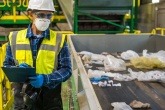Global economy needs ‘fundamental restructuring’ to achieve circularity
Circularity Gap Report 2025 shows that secondary material use increased to 7.3 billion tonnes in 2021, but is outpaced by the growing consumption of hard-to-recycle virgin resources.
 Despite an increase in secondary material use, the global economy has become less circular, according to Circle Economy’s Circularity Gap Report 2025.
Despite an increase in secondary material use, the global economy has become less circular, according to Circle Economy’s Circularity Gap Report 2025.
The decline is mainly attributed to the continued growth in virgin material use, which is outpacing the consumption of secondary materials. Due to this imbalance, the Circularity Metric dropped from 7.2 per cent in 2018 to 6.9 per cent in 2021.
According to the report, global material extraction has more than tripled in the last fifty years, reaching a landmark 100 billion tonnes each year. Although secondary material use has increased from 7.1 billion tonnes in 2018 to 7.3 billion tonnes in 2021, the scale has not been enough to offset the growth in consumption.
The table below shows a breakdown of the current state of material flow through the global economy, with the report expanded beyond the single Circularity Metric to provide analysis of circular, linear, and potentially circular material flows:
| Material Flow Type | Percentage | Scale (billion tonnes) | Category |
|---|---|---|---|
| Secondary Materials | 6.9% | 7.3 | Circular |
| Carbon-Neutral Biomass | 21.5% | 22.8 | Circular |
| Non-Carbon-Neutral Biomass | 2.2% | 2.3 | Linear |
| Virgin Non-Renewable Materials | 18.1% | 19.2 | Linear |
| Fossil Fuels for energy | 13.3% | 14.1 | Linear |
| Net Additions to Stock | 38% | 40.3 | Potentially Circular/Linear |
Table 1: Global material flow breakdown (2021)
Discussing the findings, Ivonne Bojoh, CEO of Circle Economy, said: “Our analysis is clear: even in the ideal world, we cannot solve the triple planetary crisis by mere recycling. The much-needed systemic change requires fundamental change. This means unlocking circular potential in stocks like buildings and infrastructure, managing biomass sustainably and stopping sending perfectly renewable materials to landfills.”
Achieving circularity requires “restructuring” of material handling
Secondary materials, which represent the Circularity Metric, consist of materials collected, processed and recovered from waste for another use.
Despite the growth in use, the report identifies that the key challenge lies in the systemic inefficiencies through material lifecycle - while 82 per cent of global waste is collected, only 27 per cent is actually recycled. Achieving meaningful circularity requires “fundamentally restructuring how we extract, produce and consume materials,” says the report.
However, if all waste currently not being recycled were to be recycled, the global Circularity Metric would reach 25 per cent, suggesting that true circularity requires far more than improved waste recovery. The reduction of virgin material use is a crucial marker in this aim.
Use of virgin materials hinders recycling efforts
Linear material flows, representing the Circularity Gap, comprise materials following a take-make-dispose model that aren’t cycled back into technical or ecological systems.
Virgin Non-Renewable Materials - including heavy mining and industrial waste, products that are short-lived, and end-of-life products - represent 18.1 per cent of these materials, growing from 17.9 million tonnes in 2018 to 19.2 billion tonnes in 2021. The report suggests that they could represent “significant untapped potential” for boosting circularity, with these materials accounting for 18.1 per cent of global inputs.
“If we were to recycle all waste currently not being recycled without reducing overall material use, for example, the Circularity Metric would grow to approximately 25 per cent," the report states.
However, while these materials could theoretically be recycled, the report’s analysis shows that many are hard-to-recycle without extensive treatment, which could be costly and pose additional environmental risks.
Fossil fuels used for energy represent a particularly problematic 13.3 per cent of material inputs. They are considered “inherently non-circular”, with absolute extraction increasing from 6.1 billion tonnes in 1970 to 15.8 billion tonnes in 2021.
Stock build up is another linear challenge, with 38 per cent of materials entering the economy as virgin Net Additions to Stock, which are materials that become part of buildings, infrastructure, machinery, vehicles, or other durable goods with lifespans exceeding a year. Whilst this growth is not inherently good or bad, the report emphasises that materials locked into long-lived assets creates a ‘lag’ in circularity.
Biomass remains a ‘blind spot’ in sustainability efforts
While 21.5 per cent of materials entering the economy are classified as Carbon-Neutral Biomass, the report emphasises that "a sustainable bioeconomy is important to the global circular economy transition, but measuring its impact remains a blind spot."
Biomass extraction has more than doubled over the past 50 years, despite its declining share in global material extraction. The report challenges the assumption that renewable equals sustainable, stating that “biomass isn’t sustainable by default.”
It warns that the focus on carbon neutrality as a metric of sustainability fails to account for the loss of ecological complexity and biodiversity that biomass extraction can cause.
The analysis identifies four criteria that biomass must meet to be considered truly circular: minimising environmental impact, ensuring renewability and regeneration, cascading use, and closing the nutrient cycle.
What does the Circularity Gap Report recommend?
The report synthesises its findings into five goals for stakeholders:
- Reducing global resource demand through sufficiency strategies
- Making biomass use truly sustainable with strict criteria
- Optimising material stock build-up for long-term efficiency
- Accelerating transition away from fossil fuels through electrification
- Minimising waste generation through circular design and better management
For governments, the report recommends leading through ‘smart policies’, shaping economic conditions for circularity, actively supporting global governance, and establishing an International Materials Agency to guide measurement and monitoring of sustainable resource use.
Businesses are also urged to set measurable goals using frameworks like the Global Circularity Protocol, invest in circular economy solutions to ensure competitiveness, and collaborate within value chains to optimise resource use and drive innovation.
David Rakowski, Partner at Deloitte UK, added: “Business leaders who look beyond compliance to proactively embrace a circularity mindset can help their organisations unlock new value and market opportunities, reduce costs, and build long-term supply chain resilience.
“This year’s CGR offers leaders actionable insights to help them decide where to focus their circular efforts, make meaningful progress toward their sustainability goals, and build a resilient global economy that honours our planet's limits.”








